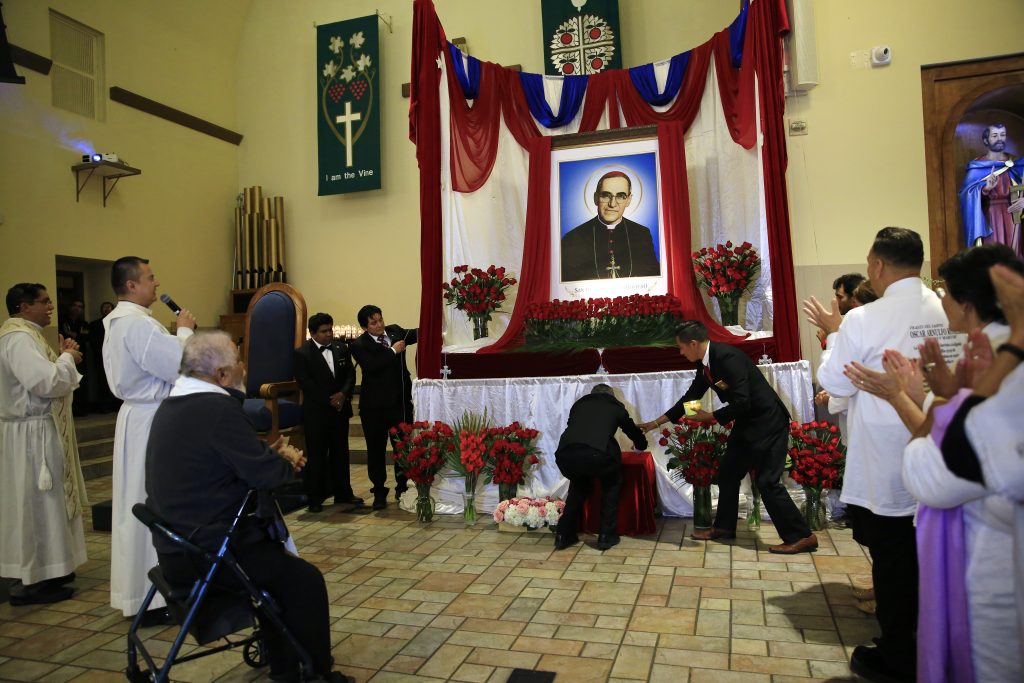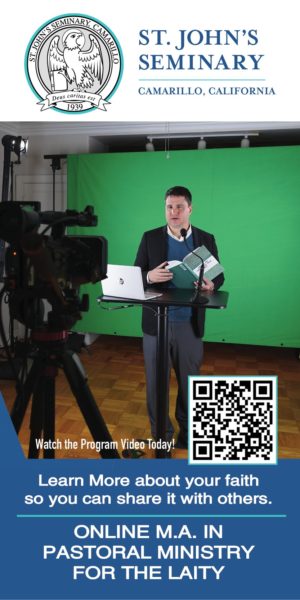On the day that Archbishop Oscar Arnulfo Romero was finally declared a saint by Pope Francis in Rome, a crowd of a thousand people made up mostly of his fellow countrymen and women filled the vast but simple church of St. Thomas the Apostle in the Pico-Union area of Los Angeles to honor him.
This is where many of the Salvadoran refugees arrived in the 1980s, fleeing war, repression, and violence, many just like Lucas Castillo, who arrived in the U.S. the very same year that a bullet pierced the heart of the archbishop of San Salvador, and silenced his voice.
Or so they thought.
“I came the same year he was killed,” said Castillo, a Salvadoran man in his 50s. “I was in the seminary for three years, the same one that he was educated in and I met him. Frankly, I compare him to historical figures such as Martin Luther King Jr. here. They both spoke the truth and were killed for it.”
The evening of Saturday, October 13 in Los Angeles was a celebration of Romero’s sainthood, but also of the lives of so many in the Salvadoran community that felt represented, loved, and cared by him.
This church was fully illuminated, adorned with white and red flowers. A large portrait of “Monse√±or Romero” was covered with white cloth waiting to be unveiled at the time of the canonization in Rome. Many attendees wore T-shirts with the archbishop’s face or held his photograph inside their Bible or over their hearts.
So many of them had a Romero story to tell.
Two large television screens were placed inside the church and in the patio, for the broadcast of the great moment. In the church kitchen, a small battalion of men and women prepared pupusas and other Salvadoran delicacies for sale to the faithful.
It was a true celebration and St. Thomas Pastor Father Mario Torres said in his homily that Romero would probably be talking about how immigrants are being treated today. “What would he do? He would call for compassion,” he said.
Celia Margarita Díaz feels that Romero would be calling on the youth of El Salvador to stop killing one another.
The middle-aged woman, who was baptized by Romero when he was still only a pastor in a church in the Salvadoran state of San Miguel, feels blessed by the canonization and she hopes his message can heal her violence-torn country.
“He would call on the youth, on the gangs, just like he did on the military when he was alive,” Díaz said. “Our country is going through so much pain again, and his voice is all too relevant now.”
She only found out about the baptism when she was about to marry and requested a copy of the document. “When I saw his name, it was very special to me. Later, I would take my two sons to his Mass, and I would always ask for him to guide them in the good path.”
Ignacio de Jesus Mercado saw Romero at the San Salvador Cathedral when he was 12 years old. His dad would sometimes travel from the town of Ilobasco to the capital for the Mass. When they could not travel, they would listen to Romero on the radio.
“We had a small radio, that’s all we had in our house,” he remembered. “He was my dad’s idol, and on the day he died I saw my father cry for the first time ever.”
That Romero raised his voice at a crucial time in his country to speak for the poor and the voiceless is repeatedly mentioned by his followers. But he also had the ability to make people feel cared for and loved.
Silvia Alvarenga, 59, met him when she was 15 years old when he met with her class at the Catholic school she attended. She most remembers sitting by him, next to him, and observing his patched-up worn clothing.
“I remember thinking he was a very simple man for an archbishop. His clothes weren’t new or fine. That day in my class, he talked to us, hugged and talked to every one of the girls, and then he mentioned us in his Sunday homily,” she recalled. “He made me feel loved, he made us feel heard. That’s why he was a pastor of the people.”
All the stories, hopes, and dreams of a refugee community now making LA their home — with children and grandchildren born and raised here — came together on this Saturday night in this church, as well as other parishes around Los Angeles where Romero was honored over the weekend.
And when Pope Francis finally declared Romero a saint of the Catholic Church, the long road of 38 years had come to an end, announcing a new beginning.
“We must not rest after this,” said Garcia. “We Salvadorans need to recommit ourselves to his message, to be able to help our country move forward.”
Pilar Marrero is a journalist and author of the book “Killing the American Dream.” She worked as a political and immigration writer for La Opinion and a consultant for KCET’s Immigration 101 series.
SPECIAL OFFER! 44 issues of Angelus for just $9.95! Get the finest in Catholic journalism with first-rate analysis of the events and trends shaping the Church and the world, plus the practical advice from the world’s best spiritual writers on prayer and Catholic living, along with great features about Catholic life in Los Angeles. Subscribe now!

